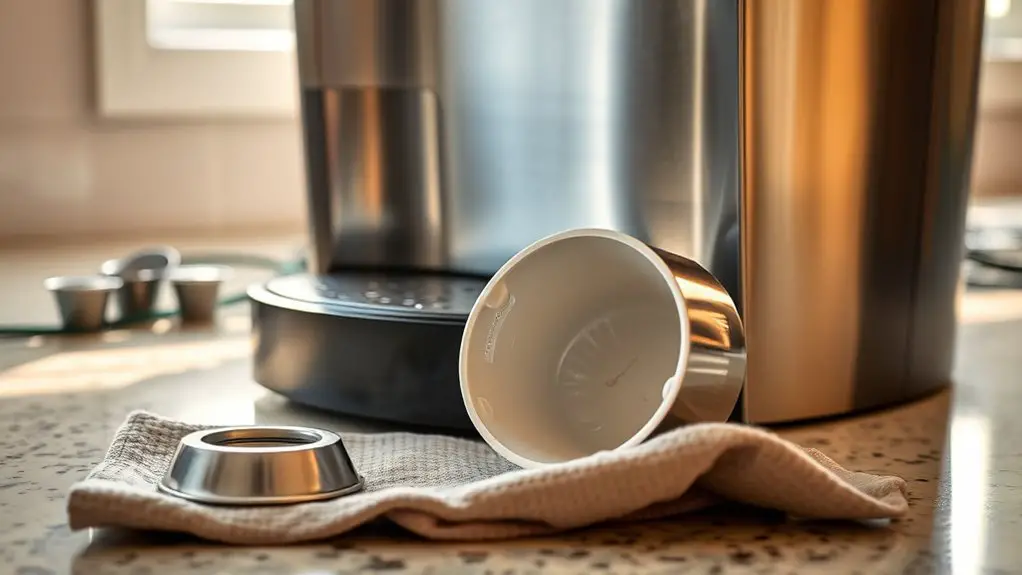If your Keurig coffee maker's leaking, it could be due to worn-out parts, misalignment, or clogs. Start by checking the water reservoir for cracks or loose connections. Next, inspect the brew head for debris or seal issues. Also, examine internal hoses and tubing for wear and ascertain the pump's working properly. Regular maintenance, like descaling and cleaning, can prevent leaks. To uncover more detailed troubleshooting steps, consider the following sections for thorough guidance.
Common Causes of Leaks in Keurig Coffee Makers
While enjoying your morning brew, you might notice water pooling around your Keurig coffee maker, which can be frustrating. Understanding common causes of leaks is essential for effective leakage prevention. One primary source is a worn-out or damaged water line, which can lead to unintended drips. Another possibility is a malfunctioning brew head; if it's not sealing properly, water may escape during brewing. Additionally, an improperly positioned drip tray can cause overflow. Regular coffee maker maintenance, like cleaning and inspecting parts, is important to prevent these issues. Check for cracks or wear in components, and maintain proper alignment. By addressing these common causes, you can enjoy your coffee without the worry of leaks disrupting your day. Also, be vigilant about clogged needle issues, as they can contribute to leaks if not addressed promptly.
Checking the Water Reservoir
A thorough check of the water reservoir is essential for identifying leaks in your Keurig coffee maker. Start by evaluating the following components:
- Inspect the reservoir gasket for any cracks or wear.
- Verify the water level is within the recommended range.
- Check for loose connections or misalignment.
- Look for any visible cracks in the reservoir itself.
- Clean the reservoir to remove any debris that may affect the seal. Regular maintenance can help prevent excess water dispensing and ensure your machine operates smoothly.
Inspecting the Brew Head
Inspecting the brew head is essential for diagnosing leaks in your Keurig coffee maker. Begin by removing the pod holder and checking for any coffee grounds or debris that might obstruct the seal. Examine the seal integrity around the brew head; any cracks or wear can lead to leaks. Next, inspect the puncture needle, ensuring it's not bent or clogged. A proper brew head inspection involves looking for any misalignment that could prevent a snug fit when the pod holder is in place. Regular maintenance, including cleaning the exit needle, can help avoid leaks and improve the overall brewing process. If you notice any issues, consider cleaning or replacing these components to restore functionality. By maintaining the brew head, you can prevent leaks and enjoy your coffee without interruption.
Examining Internal Components
Identifying leaks in your Keurig coffee maker often requires a close examination of the internal components. Focus on the following areas to diagnose potential issues:
- Internal seals: Check for any cracks or degradation.
- Water reservoir: Inspect for misalignment or damage.
- Hoses and tubing: Look for signs of wear or leaks.
- Pump mechanism: Verify it's functioning properly without blockages.
- Drip tray: Assess for overflow or improper placement.
Each of these components can influence the overall performance of your machine. Component wear over time can lead to compromised internal seals, causing leaks. Additionally, limescale clogging can obstruct the water flow, exacerbating leak issues. By methodically examining these elements, you can pinpoint the source of the problem and proactively address it for ideal brewing freedom.
Preventive Maintenance Tips
Maintaining your Keurig coffee maker is key to preventing leaks and guaranteeing peak performance over time. To achieve this, implement a routine of regular cleaning. Start by descaling the machine every three to six months to remove mineral buildup. Clean the water reservoir and drip tray with warm, soapy water regularly. Confirm that the needle is clear of coffee grounds by using a paper clip to dislodge any clogs. Additionally, regular descaling is essential for preventing future leaks and ensuring optimal machine function.
Proper storage is equally important; if you're not using your Keurig for an extended period, empty the water reservoir and unplug the machine. Avoid exposing it to extreme temperatures. By following these preventive maintenance tips, you can extend your coffee maker's lifespan and enjoy a hassle-free brewing experience.
Frequently Asked Questions
Can a Dirty Water Filter Cause My Keurig to Leak?
A dirty filter can cause various issues, including leaks. To guarantee peak performance, maintain your Keurig regularly. Clean or replace the filter often to avoid dirty filter effects and keep your machine functioning properly.
What Types of Coffee Pods Are Best to Prevent Leaks?
To prevent leaks, you should choose the best pod brands specifically designed for your Keurig. Avoid pod compatibility issues by confirming that the pods fit your model, ensuring proper sealing and minimizing potential leaks during brewing.
How Often Should I Descale My Keurig to Avoid Leaks?
So, you think your Keurig's a magical coffee fountain? It needs love too! Descaling every three to six months is essential for ideal performance. Follow these maintenance tips, and you'll keep that coffee flowing smoothly!
Is My Keurig Still Under Warranty if It Leaks?
If your Keurig's leaking, check the warranty coverage details. Typically, warranty inspections cover manufacturing defects. Document the leak and contact customer service for guidance, ensuring you maintain the freedom to enjoy your coffee experience hassle-free.
Can Using Tap Water Lead to Leaks in My Machine?
Using tap water can indeed lead to leaks in your machine. Poor tap water quality may cause mineral buildup, affecting seals and components, which ultimately results in leaks. Regular maintenance can mitigate these issues effectively.
